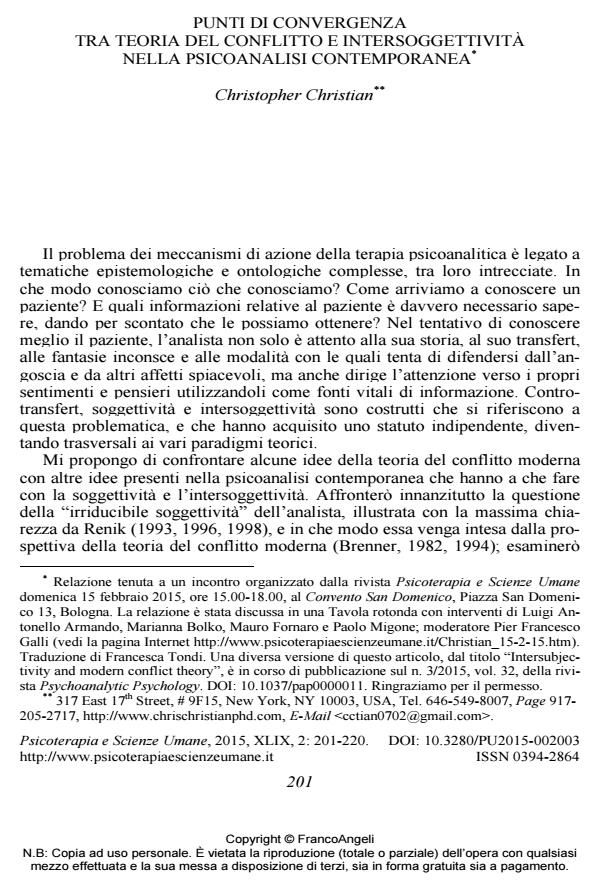Punti di convergenza tra teoria del conflitto e intersoggettività nella psicoanalisi contemporanea
Titolo Rivista PSICOTERAPIA E SCIENZE UMANE
Autori/Curatori Christopher Christian
Anno di pubblicazione 2015 Fascicolo 2015/2
Lingua Italiano Numero pagine 20 P. 201-220 Dimensione file 92 KB
DOI 10.3280/PU2015-002003
Il DOI è il codice a barre della proprietà intellettuale: per saperne di più
clicca qui
Qui sotto puoi vedere in anteprima la prima pagina di questo articolo.
Se questo articolo ti interessa, lo puoi acquistare (e scaricare in formato pdf) seguendo le facili indicazioni per acquistare il download credit. Acquista Download Credits per scaricare questo Articolo in formato PDF

FrancoAngeli è membro della Publishers International Linking Association, Inc (PILA)associazione indipendente e non profit per facilitare (attraverso i servizi tecnologici implementati da CrossRef.org) l’accesso degli studiosi ai contenuti digitali nelle pubblicazioni professionali e scientifiche
La soggettività e l’intersoggettività, così come il controtransfert, sono costrutti che hanno acquisito un loro statuto indipendente diventando trasversali ai vari paradigmi teorici. Questo articolo esplora l’intersoggettività dalla prospettiva della teoria del conflitto moderna e dimostra che vi sono molti punti in comune tra le idee degli ultimi Charles Brenner e Jacob Arlow su come funziona la mente dell’analista, da una parte, e le posizioni della psicoanalisi intersoggettiva e relazionale, dall’altra. Il concetto di intersoggettività diventa controverso quando da esso si traggono implicazioni riguardo le affermazioni che l’analista può fare sulla possibilità di conoscere la mente del paziente come entità separata dalla propria.
Parole chiave:Psicoanalisi intersoggettiva, teoria del conflitto moderna in psicoanalisi, Charles Brenner, psicoanalisi relazionale, controtransfert
- Ruoli affettivi, compiti e decisioni Alfio Maggiolini, in PSICOTERAPIA E SCIENZE UMANE 1/2017 pp.75
DOI: 10.3280/PU2017-001005 - Ascoltando, appuntando. Viaggio tra Freud e Ferenczi Silvana Valle, in PSICOTERAPIA PSICOANALITICA 1/2018 pp.35
DOI: 10.3280/PSP2018-001004 - Sul prendere appunti durante la seduta Paolo Migone, in PSICOTERAPIA PSICOANALITICA 1/2018 pp.24
DOI: 10.3280/PSP2018-001003 - Alcune pubblicazioni di Pier Francesco Galli elencate in ordine cronologico A cura della Redazione, in PSICOTERAPIA E SCIENZE UMANE 3/2024 pp.419
DOI: 10.3280/PU2024-003003
Christopher Christian, Punti di convergenza tra teoria del conflitto e intersoggettività nella psicoanalisi contemporanea in "PSICOTERAPIA E SCIENZE UMANE" 2/2015, pp 201-220, DOI: 10.3280/PU2015-002003